Theridiidae
| Tangle web spiders Temporal range: Cretaceous[1] - present | |
|---|---|
| | |
| Enoplognatha ovata[2] | |
| Scientific classification | |
| Kingdom: | Animalia |
| Phylum: | Arthropoda |
| Subphylum: | Chelicerata |
| Class: | Arachnida |
| Order: | Araneae |
| Infraorder: | Araneomorphae |
| Family: | Theridiidae Sundevall, 1833 |
| Genera | |
|
See text. | |
| Diversity | |
| 109 genera, 2295 species | |
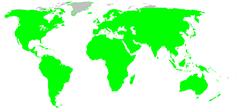 | |
Theridiidae is a large family of spiders, also known as the tangle-web spiders, cobweb spiders and comb-footed spiders. The diverse family includes over 2200 species in over 100 genera[3] of three-dimensional space-web-builders found throughout the world. Theridiid spiders are entelegyne (have a genital plate in the female) araneomorph ecribellate (use sticky capture silk instead of woolly silk) spiders that often build tangle space webs and have a comb of serrated bristles (setae) on the tarsus of the fourth leg.
The family includes some model organisms for research, for example, the genus Latrodectus, the medically important widow spiders. In addition to studies characterizing their venom and its clinical manifestation, widow spiders are broadly used in research on spider silk, and on sexual biology including sexual cannibalism.
Anelosimus spiders are also model organisms, used for the study of sociality, its evolution, and its ecological and evolutionary causes and consequences. They are particularly important for such studies as the genus contains species varying from solitary to permanently social, and because sociality has evolved frequently within the genus allowing comparative studies across species. These spiders are also a promising model for the study of inbreeding as their mating system co-varies with sociality, and all permanently social species are highly inbred.
One species in Theridion, the Hawaiian T. grallator, is used as a model to understand the selective forces and the genetic basis of color polymorphism within species. Theridion grallator is known as the "happyface" spider, as certain morphs have a pattern uncannily resembling a smiley face or a grinning clown face on their yellow body.
The family also contains the well studied kleptoparasitic species of the subfamily Argyrodinae (including Argyrodes, Faiditus, and Neospintharus) which often have triangular bodies. These spiders live in the webs of larger spiders and pilfer small prey caught by their host's web, eat prey killed by the host spider, and may consume silk from the host web, as well as attack and eat the host itself.
The largest genus with over 600 species currently placed in it is Theridion, but it is not monophyletic. Another large genus is Parasteatoda, previously Achaearanea, which includes the North American common house spider.
Many theridiids trap ants and other ground dwelling insects by means of elastic sticky silk trap lines leading to the soil surface. Despite their name, cobweb or tangle-web spiders have a huge range of web architectures.
Webs
Theridiidae is probably the only family with a large diversity of spider web forms: there is a high within-taxon diversity (e.g. in Latrodectus), as well as convergence in different taxa. Theridiid gumfoot-webs consist of frame lines that anchor them to surroundings and of support threads, which possess viscid silk. Four main web types are currently recognized: among webs with gumfooted lines, there are webs with a central retreat (Achaearanea-type) and those with a peripheral retreat (Latrodectus-type). Among webs without gumfooted lines, there are those that contain viscid silk (Theridion-type) and those with a sheet-like structure, which do not contain visible viscid silk (Coleosoma-type). However, there are many undescribed web forms.
Building of gumfooted lines constitutes a unique stereotyped behaviour and is most probably homologous for Theridiidae and its sister family Nesticidae. Webs remain in place for extended periods and are expanded and repaired, but no regular pattern of web replacement has been observed.[4] [5]
Genera
As of November 2015, the World Spider Catalog accepts the following extant genera:[6]

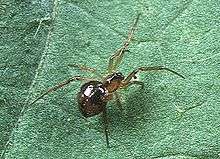
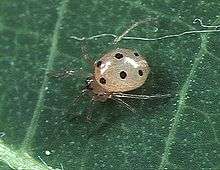
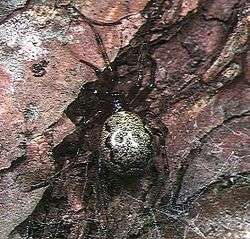
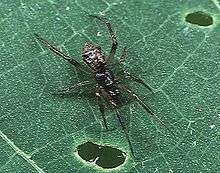
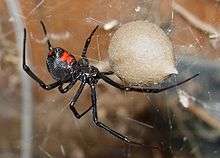
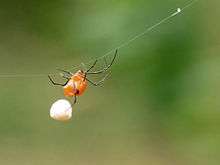
- Achaearanea Strand, 1929
- Achaearyopa Barrion & Litsinger, 1995
- Achaeridion Wunderlich, 2008
- Allothymoites Ono, 2007
- Ameridion Wunderlich, 1995
- Anatea Berland, 1927
- Anatolidion Wunderlich, 2008
- Anelosimus Simon, 1891
- Argyrodella Saaristo, 2006
- Argyrodes Simon, 1864
- Ariamnes Thorell, 1869
- Asagena Sundevall, 1833
- Asygyna Agnarsson, 2006
- Audifia Keyserling, 1884
- Bardala Saaristo, 2006
- Borneoridion Deeleman & Wunderlich, 2011
- Brunepisinus Yoshida & Koh, 2011
- Cabello Levi, 1964
- Cameronidion Wunderlich, 2011
- Campanicola Yoshida, 2015
- Canalidion Wunderlich, 2008
- Carniella Thaler & Steinberger, 1988
- Cephalobares O. Pickard-Cambridge, 1870
- Cerocida Simon, 1894
- Chikunia Yoshida, 2009
- Chorizopella Lawrence, 1947
- Chrosiothes Simon, 1894
- Chrysso O. Pickard-Cambridge, 1882
- Coleosoma O. Pickard-Cambridge, 1882
- Coscinida Simon, 1895
- Craspedisia Simon, 1894
- Crustulina Menge, 1868
- Cryptachaea Archer, 1946
- Cyllognatha L. Koch, 1872
- Deelemanella Yoshida, 2003
- Dipoena Thorell, 1869
- Dipoenata Wunderlich, 1988
- Dipoenura Simon, 1909
- Echinotheridion Levi, 1963
- Emertonella Bryant, 1945
- Enoplognatha Pavesi, 1880
- Episinus Walckenaer, in Latreille, 1809
- Euryopis Menge, 1868
- Eurypoena Wunderlich, 1992
- Exalbidion Wunderlich, 1995
- Faiditus Keyserling, 1884
- Gmogala Keyserling, 1890
- Grancanaridion Wunderlich, 2011
- Guaraniella Baert, 1984
- Hadrotarsus Thorell, 1881
- Helvibis Keyserling, 1884
- Helvidia Thorell, 1890
- Hentziectypus Archer, 1946
- Heterotheridion Wunderlich, 2008
- Hetschkia Keyserling, 1886
- Histagonia Simon, 1895
- Icona Forster, 1955
- Jamaitidion Wunderlich, 1995
- Janula Strand, 1932
- Kochiura Archer, 1950
- Landoppo Barrion & Litsinger, 1995
- Lasaeola Simon, 1881
- Latrodectus Walckenaer, 1805
- Macaridion Wunderlich, 1992
- Magnopholcomma Wunderlich, 2008
- Meotipa Simon, 1894
- Molione Thorell, 1892
- Moneta O. Pickard-Cambridge, 1870
- Montanidion Wunderlich, 2011
- Nanume Saaristo, 2006
- Neopisinus Marques, Buckup & Rodrigues, 2011
- Neospintharus Exline, 1950
- Neottiura Menge, 1868
- Nesopholcomma Ono, 2010
- Nesticodes Archer, 1950
- Nipponidion Yoshida, 2001
- Nojimaia Yoshida, 2009
- Ohlertidion Wunderlich, 2008
- Okumaella Yoshida, 2009
- Paidiscura Archer, 1950
- Parasteatoda Archer, 1946
- Paratheridula Levi, 1957
- Pholcomma Thorell, 1869
- Phoroncidia Westwood, 1835
- Phycosoma O. Pickard-Cambridge, 1879
- Phylloneta Archer, 1950
- Platnickina Koçak & Kemal, 2008
- Proboscidula Miller, 1970
- Propostira Simon, 1894
- Pycnoepisinus Wunderlich, 2008
- Rhomphaea L. Koch, 1872
- Robertus O. Pickard-Cambridge, 1879
- Ruborridion Wunderlich, 2011
- Rugathodes Archer, 1950
- Sardinidion Wunderlich, 1995
- Selkirkiella Berland, 1924
- Sesato Saaristo, 2006
- Seycellesa Koçak & Kemal, 2008
- Simitidion Wunderlich, 1992
- Spheropistha Yaginuma, 1957
- Spinembolia Saaristo, 2006
- Spintharus Hentz, 1850
- Steatoda Sundevall, 1833
- Stemmops O. Pickard-Cambridge, 1894
- Stoda Saaristo, 2006
- Styposis Simon, 1894
- Takayus Yoshida, 2001
- Tamanidion Wunderlich, 2011
- Tekellina Levi, 1957
- Theonoe Simon, 1881
- Theridion Walckenaer, 1805
- Theridula Emerton, 1882
- Thwaitesia O. Pickard-Cambridge, 1881
- Thymoites Keyserling, 1884
- Tidarren Chamberlin & Ivie, 1934
- Tomoxena Simon, 1895
- Wamba O. Pickard-Cambridge, 1896
- Wirada Keyserling, 1886
- Yaginumena Yoshida, 2002
- Yoroa Baert, 1984
- Yunohamella Yoshida, 2007
- Zercidium Benoit, 1977
About 35 extinct genera have also been placed in the family.[7]
See also
References
- ↑ Grimaldi, D.A. et al. Fossiliferous Cretaceous Amber from Myanmar (Burma): Its Rediscovery, Biotic Diversity, and Paleontological Significance. American Museum Novitates, No 3361, 2002
- ↑ Cirrus Digital Tangle Web Spider Enoplognatha ovata
- ↑ Platnick, Norman I. "The World Spider Catalog". Retrieved 2009-08-11.
- ↑ Benjamin, Suresh P. & Zschokke, Samuel 2002. Untangling the tangle-web: web building behaviour of the comb-footed spider Steatoda triangulosa and comments on phylogenetic implications (Araneae: Theridiidae). Journal of Insect Behavior, 15: 791-809
- ↑ Benjamin, Suresh P. & Zschokke, Samuel 2003. Webs of theridiid spiders: construction, structure and evolution. Biological Journal of the Linnean Society, 78: 293-305
- ↑ "Family: Theridiidae Sundevall, 1833", World Spider Catalog, Natural History Museum Bern, retrieved 2015-11-07
- ↑ Dunlop, J.A.; Penney, D.; Jekel, D. (2015). "A summary list of fossil spiders and their relatives" (PDF). World Spider Catalog. Natural History Museum Bern. Retrieved 2015-11-06.
- Agnarsson I. 2006a. A revision of the New World eximius lineage of Anelosimus (Araneae, Theridiidae) and a phylogenetic analysis using worldwide exemplars. Zoological Journal of the Linnean Society 146: 453-593. PDF
- Agnarsson I. 2006b. Asymmetric female genitalia and other remarkable morphology in a new genus of cobweb spiders (Theridiidae, Araneae) from Madagascar. Biological Journal of the Linnean Society 87: 211-232. PDF
- Agnarsson I. 2006c. Phylogenetic placement of Echinotheridion (Araneae: Theridiidae) - do male sexual organ removal, emasculation, and sexual cannibalism in Echinotheridion and Tidarren represent evolutionary replicas? Invertebrate Systematics 20: 415-429. PDF
- Agnarsson I. 2004. Morphological phylogeny of cobweb spiders and their relatives (Araneae, Araneoidea, Theridiidae). Zoological Journal of the Linnean Society 141: 447-626. PDF
- Cooperative behavior of Anelosimus jabaquara (2002). PDF
- Arnedo, M.A., Coddington, J., Agnarsson, I. & Gillespie, R.G. (2004). From a comb to a tree: phylogenetic relationships of the comb-footed spiders (Araneae, Theridiidae) inferred from nuclear and mitochondrial genes. Molecular Phylogenetics and Evolution 31:225-245. PDF
- Arnedo MA, Agnarsson I, Gillespie RG. In Press. Molecular insights into the phylogenetic structure of the spider genus Theridion (Araneae, Theridiidae) and the origin of the Hawaiian Theridion-like fauna. Zoologica Scripta.
- Aviles, L., Maddison, W.P. and Agnarsson, I. 2006. A new independently derived social spider with explosive colony proliferation and a female size dimorphism. Biotropica, 38: 743-753.
- Benjamin, S.P. and Zschokke, S. 2003. Webs of theridiid spiders: construction, structure and evolution. Biological Journal of the Linnean Society, 78: 293-305.
- Blackledge, T.A., Swindeman, J.E. and Hayashi, C.Y. 2005. Quasistatic and continuous dynamic characterization of the mechanical properties of silk from the cobweb of the black widow spider Latrodectus hesperus. Journal of Experimental Biology, 208: 1937-1949.
- Blackledge, T.A. and Zevenbergen, J.M. 2007. Condition dependent spider web architecture in the western black widow Latrodectus hesperus. Animal Behaviour, 73: 855-864.
- Gillespie, R.G. and Tabashnik, B.E. 1994. Foraging Behavior of the Hawaiian Happy Face Spider (Araneae, Theridiidae). Annals of the Entomological Society of America, 87: 815-822.
- Gillespie, R.G. and Tabashnik, B.E. 1989. What makes a happy face? Determinants of color pattern in the Hawaiian happy face spider Theridion grallator (Araneae, Theridiidae). Heredity, 62: 355-364.
- Grostal, P. and Walter, D.E. 1997. Kleptoparasites or commensals? Effects of Argyrodes antipodianus (Araneae: Theridiidae) on nephila plumipes (Araneae: Tetragnathidae). Oecologia, 111: 570-574.
- Oxford, G.S. and Gillespie, R.G. 1996. Quantum shifts in the genetic control of a colour polymorphism in Theridion grallator (Araneae: Theridiidae), the Hawaiian happy-face spider. Heredity, 76: 249-256.
- Oxford, G.S. and Gillespie, R.G. 1996. Genetics of a colour polymorphism in Theridion grallator (Araneae: Theridiidae), the Hawaiian happy-face spider, from greater Maui. Heredity, 76: 238-248.
- Purcell, J. and Aviles, L. 2007. Smaller colonies and more solitary living mark higher elevation populations of a social spider. Journal of Animal Ecology, 76: 590-597.
- Vollrath, F. 1979. Behavior of the Kleptoparasitic Spider Argyrodes-Elevatus (Araneae, Theridiidae). Animal Behaviour, 27: 515-521.
External links
| Wikispecies has information related to: Theridiidae |
| Wikimedia Commons has media related to Theridiidae. |
- Platnick, N.I. 2006. World Spider Catalog
- Key to several Theridiidae genera
- Tree of Life: Theridiidae
- Theridiidae research